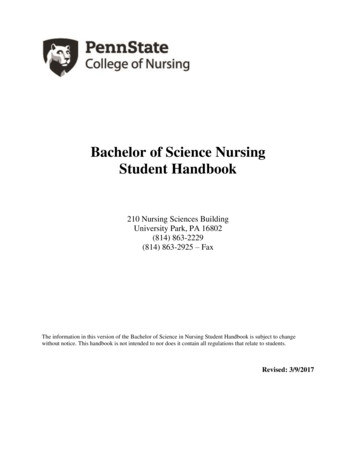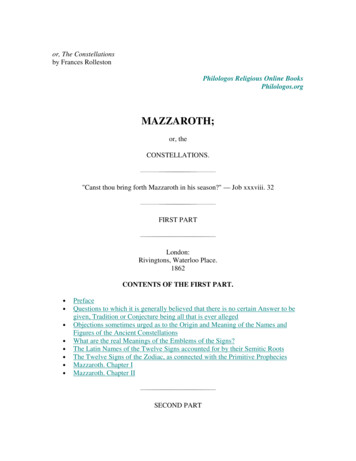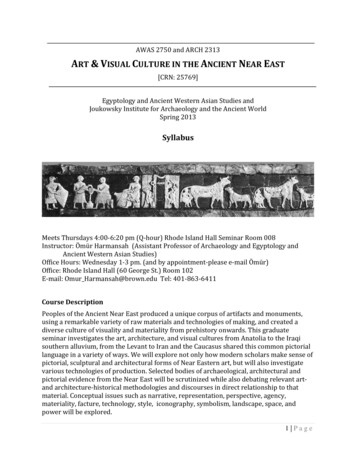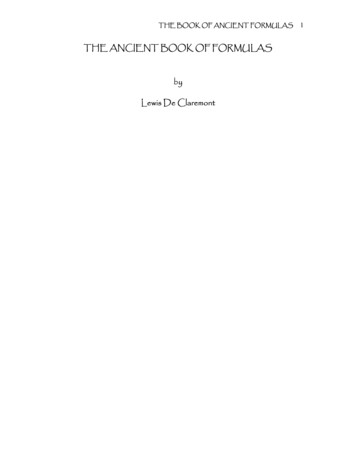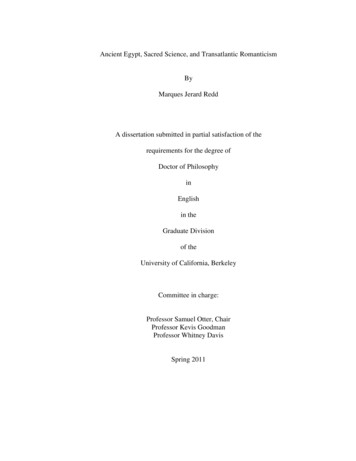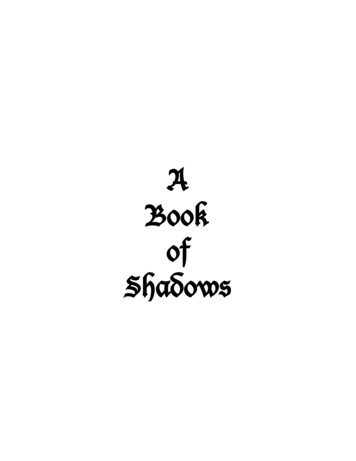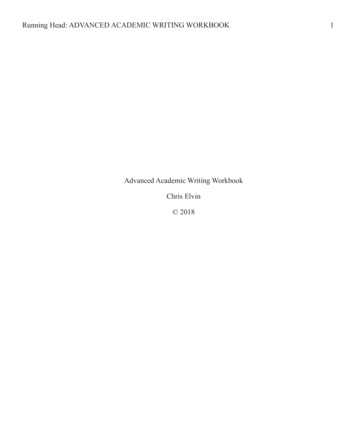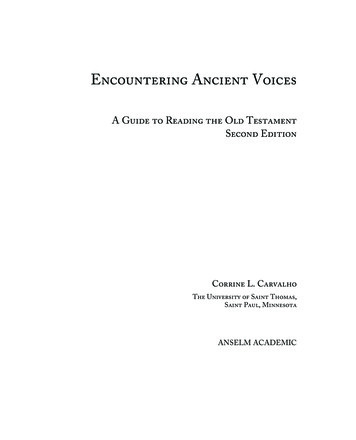
Transcription
Encountering Ancient VoicesA Guide to Reading the Old TestamentSecond EditionCorrine L. CarvalhoThe University of Saint Thomas,Saint Paul, MinnesotaAnselm Academic7026-Encounter 2nd Pgs.indb32/2/101:24:39 PM
Created by the publishing team of Anselm Academic.Cover image: Zimmermann, Clemens von (1788-1869)Farewell of the Young Tobias and his Bride from Her Parents. Ca. 1837.Oil on canvas. Inv. 14422.Neue Pinakothek, Bayerische Staatsgemaeldesammlungen, Munich, GermanyPhoto Credit : Bildarchiv Preussischer Kulturbesitz / Art Resource, NYInterior images: Zev Radovan/www.BibleLandPictures.comThe scriptural quotations contained herein are from the New Revised Standard Version ofthe Bible, Catholic Edition. Copyright 1993 and 1989 by the Division of Christian Education of the National Council of the Churches of Christ in the United States of America.All rights reserved.Copyright 2006, 2010 by Anselm Academic, Christian Brothers Publications, 702 Terrace Heights, Winona, MN 55987-1320, www.anselmacademic.org. All rights reserved.No part of this book may be reproduced by any means without the written permission ofthe publisher.First edition published 2006 as Encountering Ancient Voices: A Guide to Reading the OldTestament.Second edition published 2010 by Anselm Academic.Printed in the United States of America7026ISBN 978-1-59982-050-77026-Encounter 2nd Pgs.indb42/2/101:24:41 PM
ContentsIntroduction for the Instructor . . . . . . . . . . . . . . . . . . 1Why Another Old Testament Textbook? . . . . . . . . . . . . . . . . . . . . . . . . 11 Cracking Open a Dusty Old Book . . . . . . . . . . . . . .5Why Study the Old Testament? . . . . . . . . . . . . . . . . . . . . . . . . . . . . . . . . 6Where Was Ancient Israel Located? . . . . . . . . . . . . . . . . . . . . . . . . . . . 10The History of the Bible . . . . . . . . . . . . . . . . . . . . . . . . . . . . . . . . . . . . . 13Didn’t God Write the Bible? . . . . . . . . . . . . . . . . . . . . . . . . . . . . . . . . . 18How Should We Interpret Scripture? . . . . . . . . . . . . . . . . . . . . . . . . . . . 22How Is the Textbook Arranged? . . . . . . . . . . . . . . . . . . . . . . . . . . . . . . 232 The Patriarchs and Matriarchs . . . . . . . . . . . . . . .27Genesis at a Glance . . . . . . . . . . . . . . . . . . . . . . . . . . . . . . . . . . . . . . . . 28The Story behind the Story . . . . . . . . . . . . . . . . . . . . . . . . . . . . . . . . . . 29The World of Genesis 12–50 . . . . . . . . . . . . . . . . . . . . . . . . . . . . . . . . . 36Abraham and Sarah . . . . . . . . . . . . . . . . . . . . . . . . . . . . . . . . . . . . . . . . 41Summary: Who Are Abraham and Sarah? . . . . . . . . . . . . . . . . . . . . . . . 52The Patriarchs, the Sequel: Isaac, Jacob, and Joseph . . . . . . . . . . . . . . . 53Summary: God and the Founders . . . . . . . . . . . . . . . . . . . . . . . . . . . . . . 653 The Exodus . . . . . . . . . . . . . . . . . . . . . . . . . . . . . . . . . 67What’s the Book of Exodus? . . . . . . . . . . . . . . . . . . . . . . . . . . . . . . . . . 68Reading Exodus . . . . . . . . . . . . . . . . . . . . . . . . . . . . . . . . . . . . . . . . . . . 75Summary: God, the Liberator . . . . . . . . . . . . . . . . . . . . . . . . . . . . . . . . 864 The Sinai Covenant . . . . . . . . . . . . . . . . . . . . . . . . . 88Reading the Law through a Contemporary Lens . . . . . . . . . . . . . . . . . . 89Reading the Law . . . . . . . . . . . . . . . . . . . . . . . . . . . . . . . . . . . . . . . . . . . 977026-Encounter 2nd Pgs.indb52/2/101:24:42 PM
vi ContentsSummary: Holiness, Loyalty, and Love . . . . . . . . . . . . . . . . . . . . . . . . 119Overview: A Veil of Tears . . . . . . . . . . . . . . . . . . . . . . . . . . . . . . . . . . 1215 Conquest and Confusion: Joshua and Judges . . . 127A Doomed History . . . . . . . . . . . . . . . . . . . . . . . . . . . . . . . . . . . . . . . . 128Stories of Victory and Failure . . . . . . . . . . . . . . . . . . . . . . . . . . . . . . . . 135Summary: The Rhetorical Force of the Deuteronomistic History . . . . 1496 The Rise of the Monarchy: 1 and 2 Samuel . . . . 152To Have a King or Not to Have a King: That Is the Question . . . . . . 153Stories of the United Monarchy . . . . . . . . . . . . . . . . . . . . . . . . . . . . . . 160Summary: The King as the Father of the Nation . . . . . . . . . . . . . . . . . 1887 The Politics of the Monarchy . . . . . . . . . . . . . . . 191The Nation of Israel . . . . . . . . . . . . . . . . . . . . . . . . . . . . . . . . . . . . . . 192The Politics of the Monarchy: Reading the Books of Kings . . . . . . . . 203Summary: A Failed History Revisited . . . . . . . . . . . . . . . . . . . . . . . . . 2158 Israelite Poetry: Psalms and Song of Songs . . . 218Israelite Poetry . . . . . . . . . . . . . . . . . . . . . . . . . . . . . . . . . . . . . . . . . . . 219The Psalms . . . . . . . . . . . . . . . . . . . . . . . . . . . . . . . . . . . . . . . . . . . . . . 221Song of Songs . . . . . . . . . . . . . . . . . . . . . . . . . . . . . . . . . . . . . . . . . . . . 235Summary: God Is Present in Joy and Suffering . . . . . . . . . . . . . . . . . . 2409 The Prophets of the Divided Monarchy . . . . . . 242Defining the Prophets . . . . . . . . . . . . . . . . . . . . . . . . . . . . . . . . . . . . . 243Reading about the Prophets: The Elijah Stories . . . . . . . . . . . . . . . . . 248Reading Prophetic Books . . . . . . . . . . . . . . . . . . . . . . . . . . . . . . . . . . . 255Summary: Prophets Then and Now . . . . . . . . . . . . . . . . . . . . . . . . . . . 26510 Judah Stands Alone . . . . . . . . . . . . . . . . . . . . . . . . 268Disaster upon Disaster . . . . . . . . . . . . . . . . . . . . . . . . . . . . . . . . . . . . . 2697026-Encounter 2nd Pgs.indb62/2/101:24:44 PM
Contents viiIsaiah: Fitting Assyria into God’s Plan . . . . . . . . . . . . . . . . . . . . . . . . . 274Micah: The Prophet from Moresheth . . . . . . . . . . . . . . . . . . . . . . . . . 285Summary: Chastisement as a Confession of Faith . . . . . . . . . . . . . . . 29711 Why, Oh Lord? . . . . . . . . . . . . . . . . . . . . . . . . . . . . 299The Literature of the Exile . . . . . . . . . . . . . . . . . . . . . . . . . . . . . . . . . . 300Jeremiah: Siege and Destruction . . . . . . . . . . . . . . . . . . . . . . . . . . . . . . 304Lamentations . . . . . . . . . . . . . . . . . . . . . . . . . . . . . . . . . . . . . . . . . . . . 317Ezekiel: Watching the Whirlwind . . . . . . . . . . . . . . . . . . . . . . . . . . . . 320Summary: Great Loss, Great God . . . . . . . . . . . . . . . . . . . . . . . . . . . . 336Overview: The Second Temple Period . . . . . . . . . . . . . . . . . . . . . . . . . 33812 Restoring a Nation . . . . . . . . . . . . . . . . . . . . . . . . 344A Chance to Set Things Right . . . . . . . . . . . . . . . . . . . . . . . . . . . . . . . 344Texts from the Restoration . . . . . . . . . . . . . . . . . . . . . . . . . . . . . . . . . . 352Histories of the Restoration: Chronicles, Ezra, and Nehemiah . . . . . . 361Rewriting History, Envisioning a Future . . . . . . . . . . . . . . . . . . . . . . . 36913 The Wise Shall Behold All of Creation . . . . . . 372Where Is Wisdom Found? . . . . . . . . . . . . . . . . . . . . . . . . . . . . . . . . . . 373The Wisdom of Creation . . . . . . . . . . . . . . . . . . . . . . . . . . . . . . . . . . . 382Summary: The Wisdom of God’s Creation . . . . . . . . . . . . . . . . . . . . . 40014 A Nice Little Story . . . . . . . . . . . . . . . . . . . . . . . . 402The Art of the Storyteller . . . . . . . . . . . . . . . . . . . . . . . . . . . . . . . . . . . 402Telling Stories . . . . . . . . . . . . . . . . . . . . . . . . . . . . . . . . . . . . . . . . . . . 409Ruth: A Righteous Woman . . . . . . . . . . . . . . . . . . . . . . . . . . . . . . . 410Jonah: The Reluctant Prophet . . . . . . . . . . . . . . . . . . . . . . . . . . . . . 411Esther: Queen of Persia . . . . . . . . . . . . . . . . . . . . . . . . . . . . . . . . . . 413Tobit: The Afflicted . . . . . . . . . . . . . . . . . . . . . . . . . . . . . . . . . . . . . 416Judith: The Warrior . . . . . . . . . . . . . . . . . . . . . . . . . . . . . . . . . . . . . 417Summary: God’s Care from Least to Greatest . . . . . . . . . . . . . . . . . . . 4187026-Encounter 2nd Pgs.indb72/2/101:24:44 PM
viii Contents15 An Orchestra of Voices . . . . . . . . . . . . . . . . . . . . 420Unity and Diversity in Scripture . . . . . . . . . . . . . . . . . . . . . . . . . . . . . . 420Introducing Counter-Melodies . . . . . . . . . . . . . . . . . . . . . . . . . . . . . . 427Elements of Apocalyptic . . . . . . . . . . . . . . . . . . . . . . . . . . . . . . . . . . . . 435Summary: Theodicy, Despair, and Hope . . . . . . . . . . . . . . . . . . . . . . . 442Epilogue: Cracking Open a Familiar Book . . . . . . . . . 444What Have I Learned? . . . . . . . . . . . . . . . . . . . . . . . . . . . . . . . . . . . . . 444Reading with the Christian Community . . . . . . . . . . . . . . . . . . . . . . . 445Glossary . . . . . . . . . . . . . . . . . . . . . . . . . . . . . . . . . . . . . . 450Appendix: Maps . . . . . . . . . . . . . . . . . . . . . . . . . . . . . . . . 465Discussions of biblical texts in canonical order:Genesis 1:1—2:3 . . . . . . . . . . . . . . . . . . . . . . . . . . . . . . . . . . . . . . . . . 388Genesis 2:4—3:24 . . . . . . . . . . . . . . . . . . . . . . . . . . . . . . . . . . . . . . . . 392Genesis 6:5—9:17 . . . . . . . . . . . . . . . . . . . . . . . . . . . . . . . . . . . . . . . . 395Genesis 11:1-9 . . . . . . . . . . . . . . . . . . . . . . . . . . . . . . . . . . . . . . . . . . . 395Genesis 11:27—12:3 . . . . . . . . . . . . . . . . . . . . . . . . . . . . . . . . . . . . . . . . 41Genesis 15:1-19 . . . . . . . . . . . . . . . . . . . . . . . . . . . . . . . . . . . . . . . . . . . 45Genesis 16:1-15 . . . . . . . . . . . . . . . . . . . . . . . . . . . . . . . . . . . . . . . . . . . 43Genesis 17:1-27 . . . . . . . . . . . . . . . . . . . . . . . . . . . . . . . . . . . . . . . . . . . 45Genesis 18:1-15 . . . . . . . . . . . . . . . . . . . . . . . . . . . . . . . . . . . . . . . . . . . 45Genesis 18:16—19:38 . . . . . . . . . . . . . . . . . . . . . . . . . . . . . . . . . . . . . . . 47Genesis 21:1-8 . . . . . . . . . . . . . . . . . . . . . . . . . . . . . . . . . . . . . . . . . . . . 45Genesis 21:9-21 . . . . . . . . . . . . . . . . . . . . . . . . . . . . . . . . . . . . . . . . . . . 47Genesis 22:1-14 . . . . . . . . . . . . . . . . . . . . . . . . . . . . . . . . . . . . . . . . . . . 50Genesis 24:1-67 . . . . . . . . . . . . . . . . . . . . . . . . . . . . . . . . . . . . . . . . . . . 53Genesis 27:1-45 . . . . . . . . . . . . . . . . . . . . . . . . . . . . . . . . . . . . . . . . . . . 55Genesis 29:1-30 . . . . . . . . . . . . . . . . . . . . . . . . . . . . . . . . . . . . . . . . . . . 57Genesis 32:22-33 . . . . . . . . . . . . . . . . . . . . . . . . . . . . . . . . . . . . . . . . . . 597026-Encounter 2nd Pgs.indb82/2/101:24:45 PM
Contents ixGenesis 37:1-36 . . . . . . . . . . . . . . . . . . . . . . . . . . . . . . . . . . . . . . . . . . . 60Genesis 39:1—41:57 . . . . . . . . . . . . . . . . . . . . . . . . . . . . . . . . . . . . . . . . 60Genesis 42:1—45:28 . . . . . . . . . . . . . . . . . . . . . . . . . . . . . . . . . . . . . . . . 63Genesis 46:28—47:28 . . . . . . . . . . . . . . . . . . . . . . . . . . . . . . . . . . . . . . . 63Exodus 1:8—2:10 . . . . . . . . . . . . . . . . . . . . . . . . . . . . . . . . . . . . . . . . . . 75Exodus 3:1—4:17 . . . . . . . . . . . . . . . . . . . . . . . . . . . . . . . . . . . . . . . . . . 77Exodus 7:14—10:29 . . . . . . . . . . . . . . . . . . . . . . . . . . . . . . . . . . . . . . . . 80Exodus 11:1-10 . . . . . . . . . . . . . . . . . . . . . . . . . . . . . . . . . . . . . . . . . . . . 82Exodus 12:21-36 . . . . . . . . . . . . . . . . . . . . . . . . . . . . . . . . . . . . . . . . . . . 82Exodus 13:17—15:21 . . . . . . . . . . . . . . . . . . . . . . . . . . . . . . . . . . . . . . . 84Exodus 15:22—16:15 . . . . . . . . . . . . . . . . . . . . . . . . . . . . . . . . . . . . . . 109Exodus 19:1-25 . . . . . . . . . . . . . . . . . . . . . . . . . . . . . . . . . . . . . . . . . . . . 97Exodus 20:1-17 . . . . . . . . . . . . . . . . . . . . . . . . . . . . . . . . . . . . . . . . . . . 100Exodus 20:18-21 . . . . . . . . . . . . . . . . . . . . . . . . . . . . . . . . . . . . . . . . . . . 97Exodus 21:22—22:15 . . . . . . . . . . . . . . . . . . . . . . . . . . . . . . . . . . . . . . 104Exodus 32:1-29 . . . . . . . . . . . . . . . . . . . . . . . . . . . . . . . . . . . . . . . . . . . 112Exodus 40:16-38 . . . . . . . . . . . . . . . . . . . . . . . . . . . . . . . . . . . . . . . . . . 112Leviticus 11:1-47 . . . . . . . . . . . . . . . . . . . . . . . . . . . . . . . . . . . . . . . . . 107Leviticus 23:1-44 . . . . . . . . . . . . . . . . . . . . . . . . . . . . . . . . . . . . . . . . . 107Numbers 13:2—14:38 . . . . . . . . . . . . . . . . . . . . . . . . . . . . . . . . . . . . . 109Numbers 20:1-13 . . . . . . . . . . . . . . . . . . . . . . . . . . . . . . . . . . . . . . . . . 109Deuteronomy 4:1—6:25 . . . . . . . . . . . . . . . . . . . . . . . . . . . . . . . . . . . . 115Deuteronomy 17:14-20 . . . . . . . . . . . . . . . . . . . . . . . . . . . . . . . . . . . . 162Deuteronomy 20:1-18 . . . . . . . . . . . . . . . . . . . . . . . . . . . . . . . . . . . . . 135Joshua 6:1-27 . . . . . . . . . . . . . . . . . . . . . . . . . . . . . . . . . . . . . . . . . . . . 135Judges 3:12-30 . . . . . . . . . . . . . . . . . . . . . . . . . . . . . . . . . . . . . . . . . . . 139Judges 4–5 . . . . . . . . . . . . . . . . . . . . . . . . . . . . . . . . . . . . . . . . . . . . . . . 142Judges 11 . . . . . . . . . . . . . . . . . . . . . . . . . . . . . . . . . . . . . . . . . . . . . . . . 144Judges 13-16 . . . . . . . . . . . . . . . . . . . . . . . . . . . . . . . . . . . . . . . . . . . . . 145Judges 19-21 . . . . . . . . . . . . . . . . . . . . . . . . . . . . . . . . . . . . . . . . . . . . . 1477026-Encounter 2nd Pgs.indb92/2/101:24:46 PM
Introduction forthe InstructorWhy Another Old Testament Textbook?You may be asking yourself the same question I’ve been asking: do we reallyneed another textbook for the Old Testament? And yet, every year whenI wander through the book display at the annual meeting of the Society ofBiblical Literature, I find that many of the current textbooks have a similarformat. They tend to be “passive” in nature, providing students with information that they are meant to read and recall. Many focus on the historical background of the text, while others simply retell the biblical texts, addingsocial and cultural information. Some focus on literary issues and others ontheological matters.The best textbooks out there are too difficult for my students, who are ndergraduate students taking the course as part of their general requirements.uThe texts presume too much background and give too much detail. Ratherthan encouraging students to read the Bible on their own, the texts discourage students, who conclude that there is no way they’ll ever know enough to understand the Bible on their own.One of my primary goals as a teacher is to empower students to read theBible. I hope that after they leave my class, they will not be afraid to open theBible and read it on their own. I want them to feel confident about reading thetext and seeking reliable resources of information when necessary. It’s a simplegoal, really, one less concerned with comprehensive coverage and more focusedon reading strategies.17026-Encounter 2nd Pgs.indb12/2/101:24:49 PM
2 Introduction for the InstructorTherefore, in order to achieve my goal, I designed the textbook using fivestrategies: I wrote the book in such a way that the focus of the class will center onthe text. I tried to avoid retelling the stories, as much as possible, in orderto encourage students to read the Bible. I used active learning techniques wherever possible. This has beendifficult, since most active learning occurs when the teacher gets outof the way of student learning. Here I have done that by providingquestions that, when applied on a regular basis, help the student developgood reading skills. Each chapter includes materials that help students to learn about thesocial and cultural contexts out of which these texts were produced. Each chapter provides a legitimate variety of interpretations of the text,in order to encourage students to cultivate some ownership of their owninterpretations. Each chapter actively acknowledges contemporary approaches to readingand interpretation. While classical methods, such as source criticism, aretaught, the book also recognizes the postmodern context of our currentstudents. It tries to respect where they are, because I have found thatstudents are intensely interested in theological questions when teacherscan connect those questions to the students’ world.Except for the first chapter, which deals with broader background issues,each chapter begins with introductory material. This material usually providesan overview of the book or genre in question and provides historical and cultural information that will aid the students’ reading.This introductory section is followed by guided close readings of key biblical texts. I would not expect these texts to be the only ones that a student wouldread in class, nor would I expect a teacher to assign all of the texts. However, the supplied texts provide representative examples of how to read material in thatbook or genre. These close readings have the following format: Each reading starts with a brief introduction to the passage that oftenposes a question or issue for students to think about.7026-Encounter 2nd Pgs.indb22/2/101:24:49 PM
Why Another Old Testament Textbook? 3 Then, a section called “In Case You Were Wondering” highlightsunfamiliar words or customs. Next, students read the biblical passage. After the biblical passage, questions follow in a section titled “LookingClosely at the Text” that will help students focus on the important detailsof the text. Finally, there is a discussion of the text, either highlighting the issuesstudents were to consider or suggesting ways they could address thequestions posed.At the end of each chapter, a summary pulls together information and major themes. In addition, there are study questions and a brief bibliography (“For Further Reading”) for those times when students need more information.Each chapter also includes a number of sidebars. These recognize thatinstructors of introductory courses often have quite diverse backgroundsthemselves. Some of us are biblical scholars, while others are systematictheologians, people with a religious studies background, ethicists, and soon. The sidebars allow different instructors to focus on different aspects ofthe text.Every chapter has the following two sidebars: “Focus on Method,” which introduces a different method of biblicalinterpretation to the students. Instructors can pick and choose whichmethods to introduce. If you don’t like the order provided (I’ve tried tolink them to texts where they work best), you can easily skip around,using them as self-contained units. “The Bible in the Christian Tradition,” which focuses on someprominent interpretive traditions within Christianity. These are tied tothe content of the chapter and demonstrate how particular traditions ofinterpretation have developed. I hope that those instructors who are moreversed in the Christian tradition will use these sidebars as a jumping-offplace for larger hermeneutical discussions.In addition to these two standard sidebars, others will appear that focuson the ancient near-eastern background of the biblical material. For those7026-Encounter 2nd Pgs.indb32/2/101:24:49 PM
4 Introduction for the Instructorinstructors who want to provide a fuller treatment of a topic, such as theGilgamesh epic, these sidebars can be used as a starting point. Other sidebarsmight address Jewish interpretation of texts, historical background in moredetail, or the ways contemporary reading communities approach texts.The order of the chapters reflects the way that I teach the course. I have experimented with different structures over the years, and each one has its advantages and challenges. I struggle with the best place to introduce poetry,where to put the wisdom material, and how to teach the creation narratives.Recognizing that we all use different structures, I have tried to write someof these units in a way that would make them self-standing. Instructors canfeel comfortable moving the units around to fit their own course. You will occasionally see comments in the body of the textbook indicating material thatcan be more easily moved.At the end of the textbook you will also find a glossary of key terms andan appendix with maps.I have kept the writing style of the textbook informal. I hope that this arrative voice can serve as a model for students. Seeing the writer of thentextbook struggling with some of the same interpretive issues that they domay help empower students to accept that struggle. It also allows me to behonest about my own presuppositions, a strategy that cuts against those ofso many other textbooks where the narrator is the expert and the interpretationis “objective.”I know that this is not a textbook that will suit every instructor; no textbookcan do that. But I hope that if you, like me, teach our curious undergraduate students, few of whom will ever go on to do graduate work in theology, Scripture, or religion, you will find this book a useful tool to get your studentsto read the Bible.7026-Encounter 2nd Pgs.indb42/2/101:24:49 PM
7The Politicsof the MonarchyIndeed, Jerusalem and Judah so angered the Lord that heexpelled them from his presence.(2 Kings 24:20)Chapter OverviewIn this chapter we will focus on the literary pattern of 1 and 2 Kings, the final books of theDeuteronomistic History. We will pay particular attention to what the kings did and howtheir actions affected the fate of the nation.In the introductory material you will learn about the historical background of the timeperiod and how the historian judges the kings of Israel. This information will help you understand the nonhistorical texts that we will examine in succeeding chapters.We will concentrate on some representative “good” and “evil” kings. The narratives highlight the main ideological points of the Deuteronomistic Historian. Otherimportant texts from Kings will be assigned in future chapters, where they will be usedas background for nonhistorical texts. This chapter is designed to give you an overviewof the themes, outline, and literary style of this material, without being exhaustive ofthe contents.1917026-Encounter 2nd Pgs.indb1912/2/101:25:49 PM
192 The Politics of the MonarchyThe Nation of IsraelA Basic OutlineThe period of the monarchy can be divided into three general periods: theUnited Monarchy (ca. 1020–920 BCE), when all of the tribes were unifiedunder the rule of one king; the Divided Monarchy (920–722 BCE), whenthere were two kings, one in the north and one in the south; and the period ofJudah alone (722–587 BCE), a period after the northern kingdom had fallenand only the southern kingdom remained.The account of the United Monarchy is contained mostly in the booksof Samuel, while the books of Kings tell us about the Divided Monarchy and Judah alone.1 Samuel 13–31Reign of Saul2 Samuel 1:1—1 Kings 2:11Reign of David1 Kings 2:12—11:43Reign of Solomon1 Kings 12—2 Kings 17Divided Monarchy2 Kings 18–25Judah aloneCertainly the most confusing part of this history is the period of theDivided Monarchy. At any given moment you have two different kings, onereigning in the north and one in the south. Some of these kings have longreigns, while others last only a few months. In addition, while one king rulesone region, there may be four or more kings in the other.Also, the way the Deuteronomistic History recounts the history of the ivided Monarchy is confusing. The history starts with the southern kingdomDand speaks of the reign of its first king, Rehoboam. Next, it turns its attentionto the north and tells of the king(s) who reigned at the same time. The accountwill stay focused on the north until the time of the death of the southern king;then it will switch to the south and tell about the southern king; then it will refocus on the north, and so on.One reason it jumps around is because the redactors can assume that theirIsraelite audience is familiar with the history. The audience knows the difference between Samaria and Jerusalem, just as we know the difference betweenNew York and Los Angeles. No one would have confused Ahab and Jehoshaphat, just as we would not confuse Abraham Lincoln and Robert E. Lee.7026-Encounter 2nd Pgs.indb1922/2/101:25:49 PM
The Nation of Israel 193Kings and Prophets of the United MonarchyKingsProphetsSaul 1020–1000SamuelDavid 1000–960NathanSolomon 960–922Kings and Prophets of the Divided MonarchyKings of JudahKings of IsraelProphetsRehoboam 922–915Jeroboam I 922–901Ancient Near EastEgypt: Shishak Invades Judah 918Abijah 915–913Asa 913–873Nadab 901–900Baasha 900–877Elah 877–876Zimri 876Tibni 876–?Jehoshaphat 873–849Omri 876–869Ahab 869–850ElijahAhaziah 850–849ElishaJehoram/Joram 849–842Syria: Benhadad I 880–842Jehoram 849–842Hazael 842–806Ahaziah 842Athaliah 842–837Joash/Jehoash 837–800Jehu 842–815Amaziah 800–783Jehoahaz 815–801Rezon 740–732Joash 801–786Uzziah 783–742Jotham 750–735Ahaz 735–715Jeroboam II 786–746Amos (ca. 750)Zechariah 746–745Hosea (ca. 745)Shallum 745Menahem 745–736Syro-Ephraimitic War 734Assyria: Tiglath-Pileser 745–727Isaiah (ca. 740)Pekahiah 736–735Pekah 735–732Hoshea 732–722SamariaShalmaneser V 727–722Falls to Assyrians 722Sargon II 722–7057026-Encounter 2nd Pgs.indb193Micah (ca. 730)Damascus Falls to Assyrians in 7322/2/101:25:49 PM
194 The Politics of the MonarchyKings and Prophets of Judah AloneKings of JudahProphetsAncient Near EastAhaz 735–715IsaiahAssyria:Hezekiah 715–687IsaiahSennacherib 705–681* Siege of Jerusaem 701Manasseh 687–642JeremiahEsarhaddon 681–669Amon 642–640ZephaniahAshurbanipal 669–633?Josiah 640–609Habakkuk?Ashuretililani 633–629?Sinsharishkun 629–612* Fall of Nineveth to Babylon 612* Battle of Megiddo 609NahumEgypt: Necho 609–593JeremiahBabylon: NebuchadnezzarJehoahaz 609Jehoiakim 609–598Jehoiakin 598–597605–562(in Jerusalem)* First Deportation 597* Battle of Carchemish 605EzekielZedekiah 597–587* Fall of Jerusalem toBabylon 587We will see, however, that in the history, as well as in the psalms and theprophets, certain elements of the two kingdoms are referred to more often thanothers. This chart provides the bare bones of the Divided Monarchy.CHART OF THE TWO NATIONSSouthNorthName of the countryJudahIsraelNumber of tribes210Capital cityJerusalemSamaria (most often)Location(s) of theJerusalem (also referredDan and Bethelnational temple(s)to as “Zion”)Royal familyDavidides7026-Encounter 2nd Pgs.indb194Various families; the mostprominent were the OmridesYear the nation fell587 722To whom it fellBabylonians Assyrians2/2/101:25:50 PM
The Nation of Israel 195Notice that the word Israel is ambiguous. On the one hand, Israel meansthe whole nation, including all twelve tribes. On the other hand, Israel canalso refer solely to the northern kingdom. In addition, there were templesto Yahweh at various Israelite cities throughout the period of the DividedMonarchy.The final thing to notice is that Israel, the northern kingdom, was the largerand more prosperous nation, because it was so fertile. Although you mightconclude that it should have lasted longer, you can see that it fell almost twohundred fifty years before the south. Part of the north’s problem was that itwas more unstable than the south. It suffered many internal wars, as its thronepassed from one family to another. It had no fixed capital and no single nationalshrine. Therefore, remaining unified was more difficult for Israel. In addition,the fertility of the land and the presence of good roads made this area attractiveto foreign conquerors.Signposts of the DeuteronomistYou know that the Deuteronomistic redactors used sources in composing thishistory. These sources included lists of tribal holdings, stories of individualjudges, and David’s Court History. In the book of Kings, the redactors statethat they used royal annals (none of which have survived). They also probablyused some prophetic tales, especially those about Elijah.But even with these sources, the historian’s hand is seen most clearly in thebook of Kings. The Deuteronomistic redactors begin and end the account of eachking in a similar way. Each account starts with how old the king was when he cameto the throne, what year he came to the throne, and often who his mother was. Eachaccount ends with how long he reigned and whether he was a good or a bad king.These assessments of each monarch use a consistent set of criteria. Thekings who are evil do a number of similar things: They worship other gods. They allow for temples to Yahweh outside of Jerusalem. They maintain certain religious objects in the temple of Jerusalem that theDeuteronomists do not like. They do not listen to the prophets of Yahweh. They participate in religious rituals that the Deuteronomists considerillegitimate.7026-Encounter 2nd Pgs.indb1952/2/101:25:50 PM
196 The Politics of the MonarchyNotice that the kings are judged solely on their religious policies.It is not hard to read between the lines: most of the kings of Judah and allof the kings of Israel do not meet the Deuteronomists’ standards. And yet therewe
First edition published 2006 as Encountering Ancient Voices: A Guide to Reading the Old Testament. Second edition published 2010 by Anselm Academic. Printed in the United States of America 7026 ISBN 978-1-59
